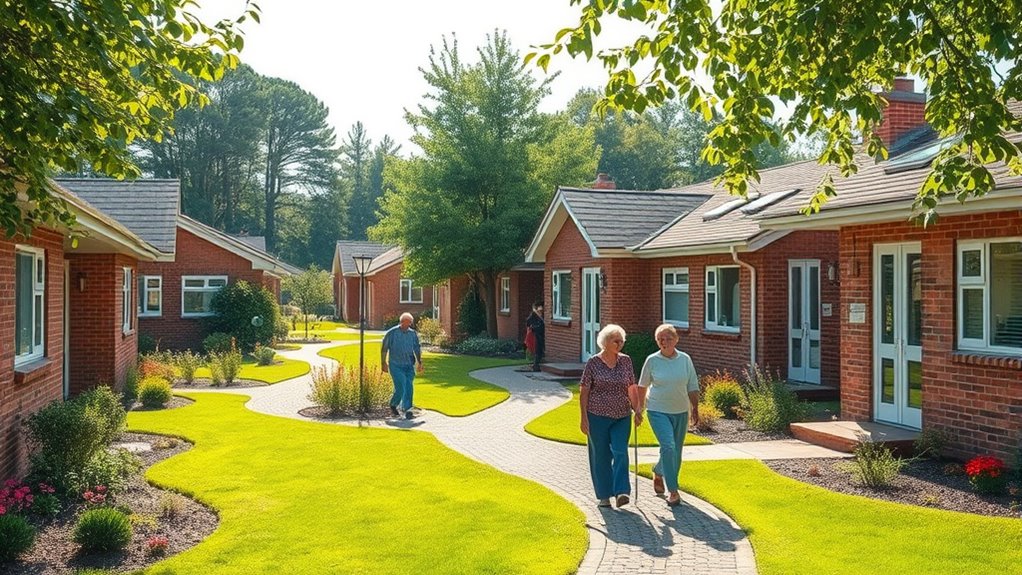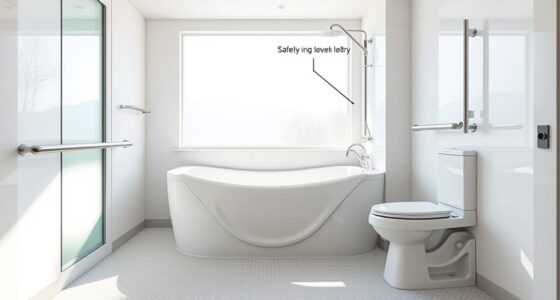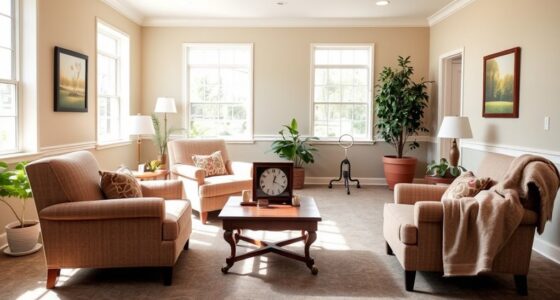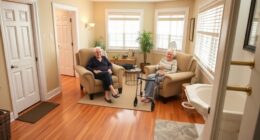Small-house nursing models create cozy, community-like units that outshine traditional long corridors by fostering comfort, safety, and efficiency. These clusters make it easier for staff to communicate quickly, respond promptly, and build stronger bonds with patients. Patients feel calmer and more at home, reducing anxiety and promoting faster recoveries. To discover how these models transform healthcare and why they’re more effective, keep exploring the details behind this innovative approach.
Key Takeaways
- Cozy clusters foster a home-like environment that enhances patient comfort and satisfaction, promoting faster recovery.
- Small units enable better communication and teamwork among staff, reducing errors and improving safety.
- They increase staff visibility and accessibility, allowing prompt responses to patient needs.
- Compact layouts reduce patient anxiety and create a calmer, less intimidating atmosphere.
- These models improve operational efficiency and human experiences by emphasizing personalized, compassionate care.

Have you ever wondered how small-house nursing models enhance patient care? These innovative designs are transforming healthcare environments by prioritizing intimacy, efficiency, and personalized attention. Instead of sprawling corridors and impersonal wards, these models create cozy clusters—small, home-like units that foster a sense of community and familiarity. When you step into one of these small houses, you immediately notice the warm atmosphere that encourages meaningful interactions between patients and staff. This setup allows caregivers to develop stronger relationships, understanding individual needs better and providing more tailored care. It boosts patient comfort and satisfaction, which can positively influence recovery outcomes.
Small-house nursing models foster community, personalized care, and a warm environment that enhances patient comfort and recovery.
The layout of small-house models promotes better communication among healthcare providers. Because staff work within a confined, familiar space, collaboration becomes more seamless. They can quickly share updates, address concerns, or coordinate treatments without the delays often caused by steering through long corridors or shifting between distant wards. This real-time teamwork reduces errors and enhances overall safety, giving you peace of mind that your loved one receives attentive, coordinated care. Moreover, the design minimizes noise and chaos typically associated with large hospitals, creating a calmer environment conducive to healing. Patients can rest easier, feeling less overwhelmed by the hustle and bustle that often characterizes traditional hospital settings.
Another significant advantage is the increased visibility of staff within small clusters. Nurses and other healthcare professionals are more accessible, allowing for frequent check-ins and prompt responses to patient needs. This constant presence ensures that issues are addressed swiftly, preventing complications and promoting quicker recoveries. Because staff are not spread thin across vast floors, they can focus their attention where it’s needed most, making rounds more effective and personalized. This proximity also encourages a team-oriented approach, where caregivers can share insights and strategies effortlessly, ultimately delivering higher-quality care.
From your perspective as a patient or visitor, small-house models create a more welcoming, less intimidating environment. Instead of feeling lost in a maze of corridors, you’re in a space that resembles a home, which can lessen anxiety and foster a sense of safety. The intimate setting also facilitates stronger bonds between patients and staff, leading to more compassionate care. Additionally, these models are often inspired by efficient healthcare layouts, which optimize space and workflow to improve overall service. Overall, these cozy clusters not only improve operational efficiency but also elevate the human experience of healthcare, proving that sometimes, smaller truly is better when it comes to healing spaces.
Frequently Asked Questions
How Do Small-House Nursing Models Impact Staff Workload?
Small-house nursing models reduce your workload by creating a more efficient environment. With fewer patients per unit, you spend less time maneuvering long corridors and searching for supplies. The intimate setting allows for better communication with colleagues and residents, streamlining care delivery. This setup minimizes disruptions and enhances teamwork, making your tasks feel more manageable and less stressful overall.
What Are the Cost Differences Between Small-House and Traditional Models?
Ever wonder if small-house models save money? They often have higher upfront costs due to building design and smaller staff areas, but you’ll find long-term savings in reduced staffing needs, fewer hospitalizations, and better resident health. While initial expenses are higher, the improved outcomes and efficiency can lower overall costs over time. So, isn’t investing in a cozy, effective environment worth it?
How Do Residents’ Privacy Levels Compare in Both Models?
You’ll find residents enjoy greater privacy in small-house models because these setups offer private rooms and intimate common areas, reducing noise and disturbances. In contrast, traditional models with long corridors often have shared rooms and open spaces, which limit privacy. This design fosters a sense of independence and personal space, making residents feel more comfortable and secure. Overall, small-house models enhance privacy and respect individual needs better than long corridor layouts.
Are Small-House Models Suitable for All Types of Care Facilities?
Small-house models work well for many care facilities, especially those focusing on person-centered care, social interaction, and independence. However, they might not suit large-scale institutions or specialized units needing advanced medical equipment or intensive care. You should consider your residents’ needs, staff resources, and facility size to determine if this model fits. While cozy clusters foster community, some settings may require traditional layouts for ideal care delivery.
What Training Is Needed for Staff Transitioning to Small-House Setups?
You need to receive specialized training in person-centered care, team collaboration, and small-house environment management. Focus on understanding residents’ individual needs, fostering a homelike atmosphere, and adapting communication skills for close-knit settings. Additionally, staff should learn new workflows, safety protocols, and how to effectively work within a smaller, more intimate team. Hands-on workshops, role-playing, and ongoing education make certain you’re prepared to deliver quality care in these cozy, efficient setups.
Conclusion
Think of small-house nursing models as a cozy village where everyone knows your name. Instead of sprawling corridors that feel like endless highways, these clusters are tight-knit communities where care feels personal and warm. Just like a village fosters connections, these models create an environment where residents thrive and staff can truly care. Embrace these cozy clusters, and you’ll see how they turn a hospital into a home—where comfort and community reign supreme.









